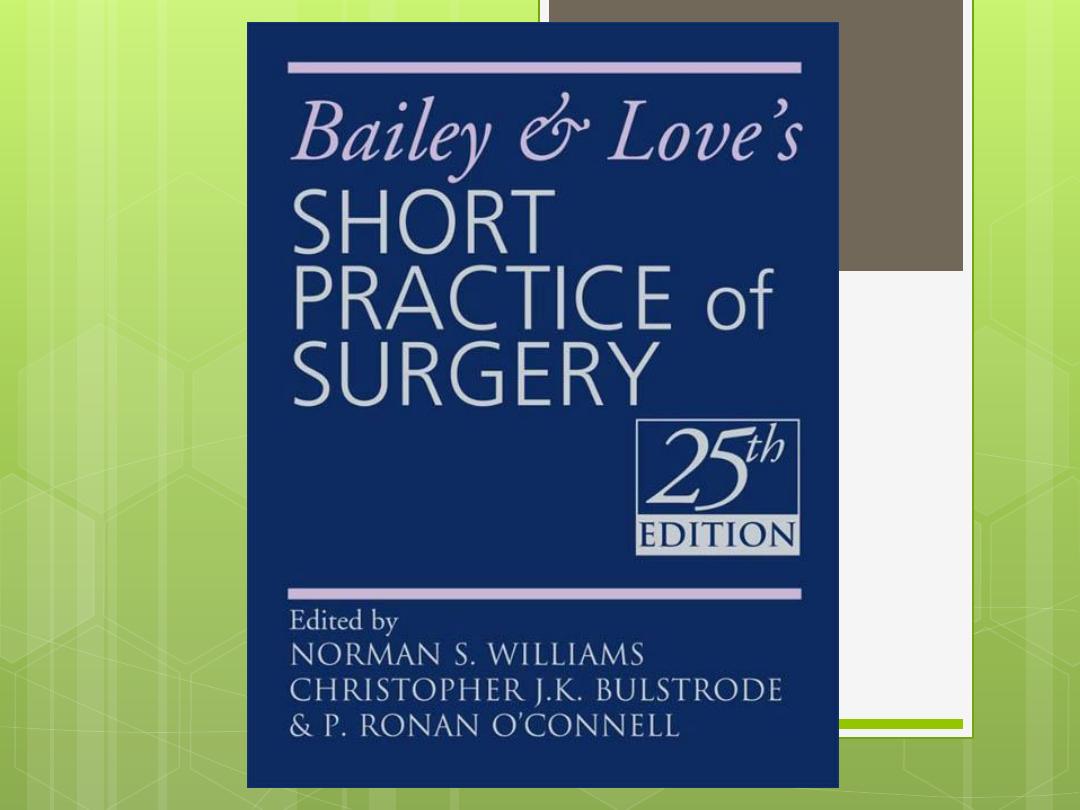
Shock
Dr. Imad AL – Fahd
Consultant Surgeon
Assistant Professor
General Surgery Dept.
Baghdad College Of Medicine


LEARNING OBJECTIVES
To understand:
• The pathophysiology of shock and ischaemia–reperfusion injury
• The different patterns of shock and the principles and priorities of
resuscitation
• The appropriate monitoring and endpoints of resuscitation

SHOCK
Complex clinical syndrome :
group of signs/symptoms that's form together a
disorder
can be observable and measurable
May be life-threatening

SHOCK
Definition- failure of circulatory system to maintain
adequate perfusion of vital organs
Leads to anaerobic cellular metabolism and
accumulated waste products
Results in inadequate tissue perfusion with decreased
oxygenation at cellular level

Classifications of shock
Hypovolemic - most common type,
inadequate circulating blood volume.
Cardiogenic - inadequate pumping
action d/t primary cardiac muscle
dysfunction
Distributive - d/t changes in blood vessel
tone that changes size of space

Pathophysiology
Adequate circulating blood volume depends
upon three interrelated components;
A minor impairment in one can be
compensated for by the other two, but
prolonged or severe impairments will lead to
SHOCK.
Heart
Vascular tone
Blood volume

Pathophysiology
Blood flows d/t driving force as leaves LV
Continuous process whereby arterioles
store blood and capillaries release it as
needed
Blood flow influenced by varying needs of
cells located nearby
Capillaries open on demand
Larger blood vessels regulated by
autonomic nervous system

PATHO
Sympathetic NS constricts blood vessels;
parasympathetic dilates blood vessels
Capillaries operate within own
mechanisms using sphincters; different
controls than autonomic nervous system
Called:
MICROCIRCULATION

Microcirculation
Autonomy exists within capillaries
No coordinated effort throughout body
Governed by local vasoactive substances
sensitive to blood flow
adjusts moment to moment
Capillaries meet with veins
Veins are low pressure and have no muscles

Blood flow
Two major receptors that sense blood
flow and volume
Arterial baroreceptors
Atrial baroreceptors

Arterial baroreceptors
Located in aortic arch
Sense how “Full system is”
Low pressure is sensed by receptors
Receptors stimulate sympathetic NS
Cardiac output is increased by:
rate and stroke volume
muscle tension

Arterial baroreceptors
Called systemic/peripheral vascular
resistance

Atrial baroreceptors
Located on right side of heart
Measures fluid volume returning to heart
Stimulates sympathetic NS to constrict
Constricts vessels in areas not considered
VITAL to survival
Brain
Heart

Mean arteial pressure
Represents the perfusion pressure
throughout the cardiac cycle
Used to assess perfusion of tissues
May be calculated as:
[(Diastolic x 2) + (Systolic x
1)] ÷ 3

MAP
A MAP > 60 is necessary to perfuse
coronary arteries, brain, and kidneys.
Ideal for heart patients with LV disorders is
70-90

EXAMPLE: MAP
B/P = 120/60 MAP = 80
60 X 2 = 120 (plus +)
120 X 1 = 120
= 240
3
= 80

Other mechanisms
Chemoreceptors located in aortic arch
and carotid bodies sense decreased pH
and increased PaCO
2
Tissues not receiving enough O
2
maintain
metabolism using anaerobic functions
Produces lactic acid as by-product
Respiratory rate may change
Increased CO
2
leads to increased
cardiac output

Other mechanisms
Juxtaglomerular receptor- located in
kidney measures blood flow to kidney
With lowered blood volume, renin is
released
Renin begins process leading to
vasoconstriction
ADH is released to prevent diuresis
Leads to water conservation and
increased blood volume

If one of three components fail, others
compensate
Vasoconstriction and increased cardiac
output used for decreased volume
Two of three must adequately function
Two or more fail---SHOCK

Types of shock
■ Hypovolaemic
■ Cardiogenic
■ Obstructive
■ Distributive
■ Endocrine
Hypovolemic
Cardiogenic
Distributive
Anaphylactic
Neurogenic
Septic

Hypovolemic shock
Most common type
Inadequate circulating blood volume
Caused by-
Hemorrhage- loss of fluid and protein
Burns-loss of fluids or fluid shifts
Dehydration- loss of fluids

Cardiogenic shock
Caused by inadequate pumping power
40% cardiac muscle dysfunction with 80%
mortality rate

Distributive shock
Due to changes in blood vessel tone that
changes size by increasing vascular
space without increasing blood volume
Results in “relative” hypovolemia
Fluid remains same but is redistributed

Distributive shock
Anaphylactic-
Acute allergic reaction from exposure to
substance client has been exposed to
Bee stings, snake bite, chocolate, iodine
Re-exposure to foreign substances leads to
antigen binding to IgE on mast cells
Mast cells release histamine,
prostagladins,etc.
S/S- massive vasodilation, uticaria (hives),
laryngeal edema, bronchial constriction

Distributive shock
Neurogenic-
Injury to spinal cord
Autonomic nervous system affected by loss
of sympathetic vasoconstriction and
smooth muscle
Leads to pooling of blood in veins
Decreased venous return to heart
Decreased cardiac output

Distributive shock
Septic-
Sepsis is systemic response to infection
Begins with growth of bacteria
Bacteria release substances called
endotoxins
Once released, lead to process and shock
Very lethal- mortality rate 20-80%
Most common causitive organism is gram +
staph, strep, fungus

Septic shock
Conditions predisposing clients include:
UTI
URI
Contaminated blood
Extreme ages
Immunosuppressed clients
Steroid use
Surgery- GU, GI
Invasive devices- IV, catheter
Men with benign prostatic hypertrophy

Stages of shock
Initial stage (early compensation stage)
Nonprogressive stage (compensatory)
Progressive stage (intermediate)
Refractory stage (irreversible)

Initial stage
Cardiac output is
d/t loss of actual or
relative blood loss
MAP
from baseline to < 10mm/Hg
Compensatory mechanisms are able to
maintain perfusion to tissues
Systemic and microcirculation work
together

Initial
aerobic metabolism with
anaerobic
metabolism
Production of lactic acid
C.O. results in
hydrostatic capillary
pressure
Fluid moves from interstitial to capillary to
increase volume

Initial
Vascular constriction and increase heart
rate help to maintain B/P
S/S: increase heart rate from client’s
baseline or slight increase in diastolic B/P
may be only manifestation

Nonprogressive-compensatory
MAP
10-15 mm/Hg from baseline
Must activate kidney and chemical
mechanisms to maintain B/P
Kidneys and baroreceptors sense
vascular volume
Release of renin; ADH; Aldosterone;
epinephrine; norepinephrine
Systemic and microcirculation no longer
work in unison

Nonprogressive
Renin secretion begins reaction- leading
to
urine output,
sodium absorption,
widespread vasoconstriction
ADH causes water reabsorption and
vasoconstriction in skin
Tissue hypoxia is present in kidneys and
skin
Anaerobic metabolism results in lactic
acid production

Nonprogressive
Acidosis (pH< 2.45)
Hyperkalemia (K
+
>5.0 mEq/l)
heart rate,
B/P,
urine output
Stimulation of thirst mechanism

Progressive stage
Sustained decrease of MAP < 20 mm/Hg
Tissue hypoxia has worsened
Vital organs are hypoxic and non-vital
organs become anoxic leading to
ischemia
Ischemia will lead to cell destruction and
death
Increased lactic acid production causes
increased capillary permeability

Progressive
Increased blood in capillaries increase
hydrostatic pressure
Fluids moves from vascular to interstitial
space
Microcirculation reverses with pooling of
blood in capillaries
Increases vascular space

Progressive stage
Increased vascular space; decreased blood
volume; decreased heart action—all
reduces MAP
All lead to venous pooling, decreased venous
return, decreased cardiac output
No mechanisms to change pattern at this
point, therefore events become more
severe
Vital organs can tolerate this for a brief time
without permanent damage

Progressive stage
Immediate interventions are necessary to
preserve life
Tolerance varies with individuals
LIFE-THREATENING
GENERALLY HAVE 1 HOUR AFTER
SYMPTOMS BEGIN TO REVERSE PATTERN

Refractory stage
Vital organs experience drastic changes
including cell destructin and death
Body is unable to reverse sequence
Metabolism is strictly anaerobic
Underlying cause may not be more
severe
Cellular ischemia and necrosis leads to
organ failure
Therapy is ineffective---DEATH

Effects on body
systems
Respiratory-
tissue hypoxia leading to anoxia
major cause of death
ARDS (acute respiratory distress
syndrome)

Effects
Acid-base-
Oxygen needed for ATP production
(energy)
Without O
2
cells use anaerobic metabolism,
producing lactic acid
Lactic acid causes cellular acidity which
damages cells and decreases C.O.
Circulation is disrupted, blood pools,
decreased venous return
VICIOUS CYCLE

Effects
Chemoreceptors sense decreased pH,
respirations increase in rate and depth to
compensate for respiratory acidosis
Respiratory alkalosis ensues.
Cellular hypoxia is not caused by
inadequate ventilation, but instead by
inadequate tissue perfusion.

Effects
As pH of cell decreases, lysosomes within
cell explode releasing destructive
enzymes
Enzymes destroy cell membrane and
digest cell contents
Once this process begins, cellular
changes are irreversible

Effects
Myocardial deterioration- as shock
progresses, heart muscle and function
deteriorates
Myocardial depressant factor (MDF)-
released d/t ischemia in GI tract.
Causes reduced C.O.

Effects
Disseminated Intravascular Coagulaion-
DIC
Sluggish blood movement & anaerobic
metabolism (lactic acid) make blood
hypercoagulable
Accompanied by hemolysis (destruction of
red blood cells)
Widespread intravascular clotting occurs
Multiple thrombi or emboli form

Effects
Leads to occluded circulation to organs
Body attempts to break down clots but not
specific—all clots are broken down
Leads to bleeding; further decreasing
vascular volume and tissue perfusion
Often fatal

Effects
Vasoconstriction- increased CO
2
dilates
arterioles in active tissues (heart)
Increased heart activity increases CO
2
which dilates coronary arteries
CO
2
is powerful vasoconstrictor in
sympathetic nervous system
Blood in inactive tissues is shunted to
tissues which need it most

Effects
Catecholamines- epinephrine and
norepinephrine are released related to
fight or flight response
Effects are to increase blood flow to brain,
heart, and skeletal muscle
Decrease blood flow to skin, kidneys, GI
tract

Effects
Histamine –
causes vasodilation
Increased capillary membrane
Bronchoconstriction
Coronary vasodilation
Cutaneous reaction (flares, wheals)

Effects
Vasoactive polypeptides-
Bradykinin- vasodilation, capillary
permeability, pain, acti6ve in late shock
Angiotension- vasoconstriction and
increased SVR
MDF- depresses cardiac muscle
contraction

Effects
Adrenal medulla releases epinephrine
and norephinphrine
Increases respiratory and heart rates,
increased B/P
Release of mineralocorticoids- aldosterone
and glucocorticoids- desoxycorticosterone;
effects fluid and electrolyte balance
through sodium and water, energy in tissue

Effects
ADH- also called vasopressin; from
pituitary gland; tells kidneys to conserve
water
MANY OTHER EFFECTS ON BODY!!!!

General clinical manifestations
Shock had many diverse S/S
Subjective complaints are usually
nonspecific
Observable and measurable are often
conflicting

S/S
Tachypnea-
Rapid, shallow respirations (tachypnea) d/t
tissue hypoxia

S/S
Tachycardia-
Generally pulse rate increases
Becomes weak and thready
May be unreliable due to pain, fear, anxiety
Be aware of clients taking beta-blockers
and elderly with heart block

S/S
Hypotension-
Systolic B/P indicates integrity of heart,
arteries, and arterioles
Diastolic B/P indicates peripheral vascular
resistance (vasoconstriction)
When diastolic falls significantly, indicates
vasoconstriction in being lost as a
compensatory measure

S/S
B/P usually falls when total blood volume is
decreased by 15-20%
In young adults, falling B/P is a sign of late
shock
With progression, both fall, but systolic falls
more
Pulse pressure narrows- systolic – diastolic
Therefore pulse pressure is more significant
in late shock than B/P

S/S
It parallels stroke volume- if stroke volume falls, it
means volume of blood ejected is less
Pulse pressure may decrease before B/P and
can be a more reliable indicator or severity of
condition
Minimum of 60-70 mm Hg systolic to maintain
coronary circulation
Must know baseline B/P to interpret findings
Hypotension by itself does not indicate shock

S/S
In early shock, systolic B/P is unreliable; may
be elevated due to compensation
Assess strength of femoral pulses

S/S
Level of consciousness
Early shock produces stimulation of SNS
leading to feelings of anxiety, fear, irritability
Dizziness, faintness, unconsciousness (if
sudden onset)
Apathy, confusion, restlessness, increased
alertness ( if gradual onset)
With narcotics, must be careful not to mask
situations

S/S
Oliguria-
Fall in UO is often the earliest sign; one of
the most sensitive indices in shock
However, if shock occurs suddenly, other
S/S will present before urine output
decreases
UO must be kept above 0.5 ml/kg/hr (35
ml/hr)

Hypovolemic shock
Primary event is large reduction in blood
volume
Urine osmolality and specific gravity
increase d/t water and Na
+
retention
Stimulation of SNS leads to diaphoresis,
losing more fluid- skin feels cool, clammy,
pale
Increase heart and respiratory rate

Hypovolemic
Cyanosis is a LATE sign
Decreased pulse pressure; normal is 30-50
Decreased LOC
Decreased DTR

Septic shock
Caused by bacterial infection
Early stages body experiences massive
vasodilation
Warm, dry, flushed skin d/t increased C.O.
and increased perfusion of skin
Often referred to as “warm shock”
Later stages show pale, cold, clammy,
mottled skin; decreased body temp.;
crackles and wheezes in lungs; drowsiness
and stupor

Septic shock
Referred to as “cold shock”
May eventually develop ARDS
pulmonary failure following successful
resuscitation from hypotension
develops 1-6 days after treatment
client looks well, but hyperventilation, cough,
elevated
PCO
2
, & low PO
2
treated with ventilatory support (PEEP), oxygen,
diuretics, heparin, and steroids
high mortality rate with ARDS

Septic shock
Toxins and endotoxins secreted by
bacteria lead to whole body
inflammatory response
Systemic inflammatory response
syndrome (SIRS)- alter microcirculation,
increase capillary permeability, cause cell
injury, clot formation, and anaerobic
metabolism

Septic shock
Capillary leak syndrome- fluid shift from
intravascular to interstitial spaces is a
complication

Diagnosis
Assess oxygenation
Spirometry measurements
Pulse oximeter
ABG’s
PCO
2
is key to detecting compensatory
acidosis
Rising PCO
2
with low pH & bicarbonate
Indicates respiratory assistance is needed

Diagnosis
Cardiac monitoring
EKG
Labs
CBC
Lytes
Body fluid cultures
obtain culture and sensitivity (C&S) before
antibiotics are started.

Treatment
It is difficult to ascertain when shock
begins. Therefore tx. Should be instituted
when at least two of the following are
present
Systolic B/P of 80 mm HG or less
Pulse pressure of 20 mm Hg or less
Pulse rate of 120 or more

Treatment
Maintain patent airway
Supplemental O
2
Modified trendelenberg- lower extremities
elevated 30-45
0
, knees straight, trunk
horizontal, head level with chest
Promotes venous return by not compressing
diaphragm, mobilizes pooled blood

Treatment
REPLACE FLUIDS
Use IV therapy with large bore catheter or
central line
Carefully monitor infusion of fluids
When UO is 60ml/hr or>, B/P is >100 systolic,
or heart rate is 60-100, fluids should be
tapered off
General rule is 3:1 : for a client’s blood loss,
3 times as much fluid should be given

Types of fluid
Crystalloid or balanced salt solutions:
D
5
W should not be used
2/3 crystalloid solution will leave ECF to
Interstitial
Use NS, RL, 1/2NS
RL or NS expand volume, reduce viscosity,
prevent sludging
With liver dysfunction, using lactate will
increase acidosis, so consider other fluids than
RL

Types of fluids
Colloid solutions- contains proteins to
increase osmotic pressure in ECF
Plasma- Fresh Frozen Plasma (FFP)- requires
thawing for 15-30 min.
Albumin- may move into pulmonary space
and contribute to ARDS
Dextran- can rapidly expand ECF, but
interferes with type and crossmatch of
blood
Blood products- PRBC’s or whole blood

Types of fluids
Fluids given in excess of normal volume
should be other than blood so they can
easily be removed by kidneys

Other treatments
Monitor urinary output
Use indwelling catheter
Diuretics usually used
Dialysis with tubular necrosis of kidney (ATN)
Oliguria does not contraindicate large
volumes of fluids

Other treatments
Perfusion to GI will be decreased. May
result in inadequate perfusion, delayed
emptying, vomiting, & possible aspiration
Insert NG tube with suctioning
Assess periodically for blood

Other treatments
Do not apply heat to skin, heat dilates
and draws blood away from vital organs
Heat also increases metabolism and need
for more O
2
& adds strain to the heart
Do not allow to become cold- chilling
requires extra energy, contributes to
sludging of blood, slows heart rate, inhibits
body’s reparative processes

Multiple organ failure
syndrome
Sequential organ failure of lung, liver, and
kidney, usually followed by death. 50-90%
mortality. All three organs involved: 100%
Several etiologies:
Dead tissue, injured tissue, infection
Persistent inflammation- pancreatitis,
pneumonitis
Acute lung injury – usually present

MOFS
Clients at high risk-
Impaired immune response
Elderly
Chronic illnesses
Malnutrition
Cancer
Severe trauma
Sepsis

MOFS
Prevention is key
Remove potential sources of sepsis
Predictive variables-
Ratio of PO
2
to FIO
2
on day 1;
Plasma lactate level or day 2;
Serum bilirubin on day 6;
Serum creatinine on day 12

MOFS - PATHO
Events start with local injury from trauma,
infection, or lack of perfusion
Bacteria is introduced with activation of
systemic inflammatory response (SIRS)
Bacterial release toxins that further
activate SIRS
Once systemic, chemical mediators
control response

MOFS - PATHO
Endothelial cells are destroyed
Blood flow to tissues reduced
When inflammatory response is
unchecked, damage to organs occur
Lungs are usually the first to malfunction
GI system is second system

MOFS
Two types- type I and type II
Type I
Becomes evident only few days before
death
Most commonly seen after pulmonary injury
Small percentage develop this

MOFS
Type II-
Does not progress until 7-14 days after initial
event
Occurs with septic shock and ARDS

Clinical manifestations
Preciptating event associated with
hypotension
Client is resuscitated, cause treated
SIRS is experienced
Within few days insidious onset of S/S

Events
Low grade fever
Tachycardia
Increased # banded neutrophils
Dyspnea with infiltrates on x-ray
Deterioration in mental status
Reasonably normal renal and liver labs
Dyspnea progresses with mechanical
ventilation

Events
Some evidence of DIC
Often have increased serum glucose
7-10 days bilirubin rises as well as
creatinine
Blood glucose and lactate levels rise
Delayed healing
Client needs fluids and meds to keep
blood volume normal

Events
Day 14-21, client is unstable; close to
death
Renal failure occurs
Anasarca or edema is present d/t low
protein
Lactic acidosis worsens
Incorrectable DIC

Events
Day 21, evident that death will occur- 21-
28 days after precipitating event
Not all die
Leading cause of death in ICU

Endpoints of resuscitation
It is much easier to know when to start resuscitation than
when
to stop.
Traditionally patients have been resuscitated until the
have a normal pulse, blood pressure and urine output;
however, these parameters are monitoring organ systems
whose blood flow is preserved until the late stages of
shock.
Therefore, a patient may be resuscitated to restore central
perfusion to the brain, lungs and kidneys and yet the gut
and muscle beds continue to be under perfused. Thus,
activation of inflammation and coagulation may be on-
going and, when these organs are finally perfused, it may
lead to reperfusion injury and ultimately multiple organ
failure.
